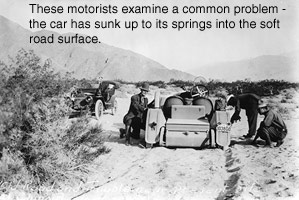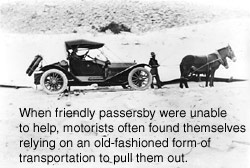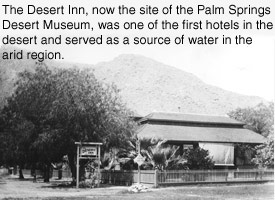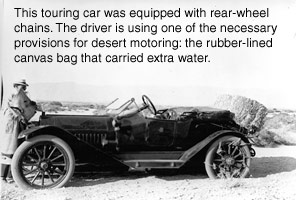"Back in the old days, you had to be made of pretty adventuresome stuff to drive to the desert. The Automobile Club of Southern California, celebrating its 100th anniversary, reaches into its archives and tells it like it was."
By Mona Ziada
The challenge and majesty of spectacular scenery in remote areas of the world lure today's adventurous travelers to scale mountains, cruise jungle rivers and mingle with wild game on safaris. But less than 100 years ago, Southern California's desert was the unexplored frontier that attracted the hardiest travelers to explore its scenic beauty.
 During the first years of the 20th century, automobiles promised their owners the freedom and flexibility to travel to places previously unreachable by humans. They could pack up their new machines and head northeast from Los Angeles, Orange and San Diego counties to explore the unknown desert terrain of Riverside and San Bernardino counties. Their destinations, inhospitable and remote, had been inaccessible just a decade earlier. Even though these areas could now be reached by automobile, getting there was by no means an easy task. Drivers had to equip their cars with rear-wheel chains to avoid getting stuck in sand. But even chains couldn't always prevent a common problem encountered by early motorists – sinking up to the auto's springs into the soft road surface. Sometimes, even chains couldn't prevent motorists from getting stranded. They had to resort to a nearby farmer (and his 19th-century equipment) to haul them out.
During the first years of the 20th century, automobiles promised their owners the freedom and flexibility to travel to places previously unreachable by humans. They could pack up their new machines and head northeast from Los Angeles, Orange and San Diego counties to explore the unknown desert terrain of Riverside and San Bernardino counties. Their destinations, inhospitable and remote, had been inaccessible just a decade earlier. Even though these areas could now be reached by automobile, getting there was by no means an easy task. Drivers had to equip their cars with rear-wheel chains to avoid getting stuck in sand. But even chains couldn't always prevent a common problem encountered by early motorists – sinking up to the auto's springs into the soft road surface. Sometimes, even chains couldn't prevent motorists from getting stranded. They had to resort to a nearby farmer (and his 19th-century equipment) to haul them out.
As early motorists were beginning to explore their surroundings, they recognized the need to band together to further their interests in obtaining construction and funding for safer, more reliable roads. That's when 10 auto enthusiasts in Los Angeles joined together and formed the Automobile Club of Southern California, according to Mathew Roth, historian for the Auto Club.
 The Auto Club met member needs by producing the earliest road maps of Southern California and posting the first directional road signs starting in 1906. These maps and road signs helped reassure motorists that they could find their way to and from their desert outings.
The Auto Club met member needs by producing the earliest road maps of Southern California and posting the first directional road signs starting in 1906. These maps and road signs helped reassure motorists that they could find their way to and from their desert outings.
Another source of information for motorists was Touring Topics, the Auto Club's original member magazine first published in 1909. One of the most frequently featured topics was desert touring. "The informative articles provided members with detailed accounts of trips taken by motorists, road conditions, scenic attractions such as the wild flowers in winter and available accommodations," says Roth. "They were lured to the desert by the scenic attractions – and a sense of adventure since they were the first to travel through these unfamiliar areas. They were fascinated by the sublime landscapes."
Early motorists visiting places like the Coachella Valley had to deal with the harsh environment and lack of supplies, food, water and gas. One of the first hotels to help meet these needs was the Desert Inn, located in today's downtown Palm Springs. Built in the first decade of the century, the inn was featured on all Auto Club maps as one of the few sources of water in the arid region. It was also a key stop for motorists on their way to Indio.
 "By the 20s, there was a change in how remote, rough landscapes were perceived," explains Roth. "Instead of being viewed as risky, dangerous obstructions that stood in the way of their ultimate destinations, travelers now saw isolated desert areas as escapes from their urban surroundings. Nature, therefore, became a diversion from everyday life that provided an uplifting experience."
"By the 20s, there was a change in how remote, rough landscapes were perceived," explains Roth. "Instead of being viewed as risky, dangerous obstructions that stood in the way of their ultimate destinations, travelers now saw isolated desert areas as escapes from their urban surroundings. Nature, therefore, became a diversion from everyday life that provided an uplifting experience."
In the 1930s, Westways magazine, formerly Touring Topics, published works by scientists who were studying the desert, Roth relates. These articles offered readers the opportunity to learn about the animal and plant life found in the desert as well as topics such as geology, paleontology and ecology. These well-informed readers grew to appreciate the desert for its unique beauty and abundance of wildlife.
Desert travel became safer when the Auto Club established emergency roadside service (ERS) in the late 20s – and by the 30s had set up contracts with service stations in the desert areas. This, along with the Auto Club's tourbooks, which included lists of accommodations providing good service at reasonable rates, reassured travelers as they ventured through the desert that reliable help was nearby.
" There's no doubt that the Auto Club's maps, road signs, magazine articles, tourbooks and emergency roadside service played a role in developing desert tourism," explains Roth. "It's also interesting to note that many desert locales photographed by the Auto Club for its publications are today protected areas such as Death Valley, Joshua Tree and Anza-Borrego."
There's no doubt that the Auto Club's maps, road signs, magazine articles, tourbooks and emergency roadside service played a role in developing desert tourism," explains Roth. "It's also interesting to note that many desert locales photographed by the Auto Club for its publications are today protected areas such as Death Valley, Joshua Tree and Anza-Borrego."
The deserts may have been tamed since the earliest days of the automobile, but the basic needs of travelers remains the same – safe roads, reliable maps, prompt roadside service and information on affordable, clean accommodations. One hundred years later, the Auto Club continues to fulfill its promise of providing service to its members, who now number five million throughout Southern California.